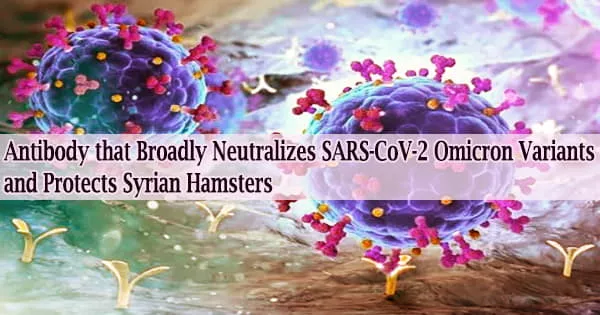Researchers at the AIDS Institute, The University of Hong Kong (HKU), Department of Microbiology, School of Clinical Medicine, the LKS Faculty of Medicine of The University of Hong Kong (HKUMed), and the State Key Laboratory of Emerging Infectious Diseases, HKU, together with structural biologists at The Hong Kong University of Science and Technology (HKUST), has shown that ZCB11, a broadly neutralizing antibody against the spreading Omicron variants of SARS-CoV-2 derived from a local mRNA-vaccinee, exhibits potent antiviral activities against all variants of concern (VOCs), including the dominantly spreading Omicron BA.1, BA1.1, and BA.2.
Importantly, preventive or therapeutic ZCB11 treatment shields golden Syrian hamsters from lung infection when challenged with the Omicron virus. The study’s online publication in Nature Communications has just happened.
Background
The effectiveness of existing vaccinations and antibody immunotherapy has been severely hampered by the startlingly high transmissibility and antibody evasion of SARS-CoV-2 Omicron variants.
Universal masking, quarantine, and ongoing viral testing must be maintained in response to the ongoing appearance of SARS-CoV-2 Omicron variants with unexpected pathogenicity, causing social unrest and economic devastation.
Therefore, it is crucial to research whether the host immune response can produce broadly neutralizing antibodies, which is crucial for both vaccine optimization to produce an equally broad immune response and antibody-based immunotherapy.
Research methods and findings
The HKUMed team has developed a powerful platform for cloning technology that natively couples antibody genes from distinct human memory B cells in this work.
The findings suggested that ZCB11 is a promising antibody drug for biomedical interventions against pandemic SARS-CoV-2 variants of concern. Although our findings implicate that the HKUMed team is at the world’s forefront of research and development of human antibody drugs and vaccines against COVID-19, we still urgently need to establish a large-scale manufacturing capacity and clinical translational hubs in Hong Kong, in order to meet its aspiration of becoming an international innovation center.
Professor Chen Zhiwei
After screening 34 recipients of the BNT162b2 vaccine in Hong Kong, the research team used this method to successfully identify ZCB11. They then showed that ZCB11 neutralizes all VOCs, including Alpha (B.1.1.7), Beta (B.1.351), Gamma (P1), Delta (B.1.617.2), and Omicron (B.1.1.529) by testing both fake viruses and real-live viruses.
Importantly, both prophylactic and therapeutic ZCB11 treatment protects golden Syrian hamsters from a lung infection caused by live Omicron and Delta virus challenges.
Significance of the study
“The findings suggested that ZCB11 is a promising antibody drug for biomedical interventions against pandemic SARS-CoV-2 variants of concern,” remarked Professor Chen Zhiwei, Director of AIDS Institute and Professor of the Department of Microbiology, School of Clinical Medicine, HKUMed, who led the study.
“Although our findings implicate that the HKUMed team is at the world’s forefront of research and development of human antibody drugs and vaccines against COVID-19, we still urgently need to establish a large-scale manufacturing capacity and clinical translational hubs in Hong Kong, in order to meet its aspiration of becoming an international innovation center.”
“The high-resolution structural information enabled us to understand the molecular mechanism of ZCB11 responding to a broad SARS-CoV-2 variant of concern,” said Professor Dang Shangyu, Assistant Professor of Division of Life Science, HKUST.
“This study relies on the state-of-the-art cryo-EM facility at HKUST, which demonstrated its capability to support not only research in structural biology but also many other research fields, such as antibody development in this study.”
About the research team
The research is led by Professor Chen Zhiwei, Director of AIDS Institute and Professor of the Department of Microbiology, School of Clinical Medicine, HKUMed; and was conducted primarily by Mr. Zhou Biao, PhD candidate. Dr. Zhou Runhong, research officer; Dr. Jasper Chan Fuk-woo, Clinical Associate Professor; Luo Mengxiao and Peng Qiaoli, PhD candidates; Dr. Yuan Shuofeng, Assistant Professor at the Department of Microbiology, School of Clinical Medicine, HKUMed. Tang Bingjie and Liu Hang, MPhil students of the Division of Life Science, HKUST, shared the first authorship.
This collaborative team also includes Dr. Bobo Mok Wing-yee, Scientific Officer; Chen Bohao; Dr. Wang Pui, Scientific Officer; Vincent Poon Kwok-man; Dr. Chu Hin, Assistant Professor; Chris Chan Chung-sing, Jessica Tsang Oi-ling, Chris Chan Chun-yiu, Au Ka-kit, Man Hiu-on, Lu Lu, Dr. Kelvin To Kai-wang, Chairperson and Clinical Associate Professor; Professor Chen Honglin; Professor Yuen Kwok-yung, Henry Fok Professor in Infectious Diseases and Chair of Infectious Diseases, Department of Microbiology, School of Clinical Medicine, HKUMed and Director of the State Key Laboratory of Emerging Infectious Diseases, The University of Hong Kong. Professor Dang Shangyu and Professor Chen Zhiwei shared the correspondence authorship.
Acknowledgments
Hong Kong Research Grants Council Collaborative Research Fund (C7156‐20GF, C1134‐20GF, and C5110‐20GF) and Health and Medical Research Fund from the Food and Health Bureau (19181012 supported this study); Shenzhen Science and Technology Program (JSGG20200225151410198 and JCYJ20210324131610027); the Hong Kong Health@InnoHK, Innovation and Technology Commission, the Government of the Hong Kong Special Administrative Region; and the China National Program on Key Research Project (2020YFC0860600, 2020YFA0707500 and 2020YFA0707504); and donations from the Friends of Hope Education Fund in Hong Kong. Professor Chen Zhiwei’s team was also partly supported by the Hong Kong Research Grants Council Theme‐based Research Scheme (T11‐706/18‐N) and Wellcome Trust P86433.
All cryo-EM data were collected at the Biological Cryo-EM Center at HKUST, generously supported by a donation from the Lo Kwee Seong Foundation, together with support to Professor Dang Shangyu’s team from the Research Grants Council (RGC) of Hong Kong (ECS26101919, GRF16103321, C7009-20GF, C6001-21EF), Southern Marine Science and Engineering Guangdong Laboratory (Guangzhou) (SMSEGL20SC01-L), Guangdong Basic and Applied Basic Research Foundation (2021A1515012460), Shenzhen Special Fund for Local Science and Technology Development Guided by Central Government (2021Szvup140) and HKUST start-up and initiation grants.





